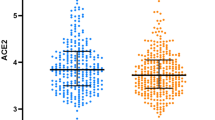Abstract
Preeclampsia is a hypertensive disorder unique to pregnancy. Although the pathogenesis of the disease begins with aberrant spiral artery invasion in the first trimester, clinical symptoms usually do not present until late in pregnancy. Apolipoprotein CII (ApoCII) and its negative regulator, apolipoprotein CIII (ApoCIII), have recently been described as atherogenesis biomarkers in models of cardiovascular disease. Given the similarities in pathology, etiology, and clinical presentation between cardiovascular disease and preeclampsia, we hypothesized that the ratio of ApoCIII to ApoCII in maternal first trimester plasma would predict preeclampsia later in pregnancy. To test this hypothesis, plasma was prospectively collected from 311 nulliparas at 8 to 12 weeks gestation. After delivery, patients were divided into cohorts based on preeclampsia diagnosis. Conditioning monocytes with preeclamptic plasma potentiated monocyte adhesion to endothelial cells in an in vitro model. The ratio of ApoCIII to ApoCII was significantly elevated in patients with severe preeclampsia relative to normotensive and gestational hypertensive individuals (P <.05) as determined by mass spectrometry and competitive enzyme-linked immunosorbent assay (ELISA) assays. These results support a predictive change in the ratio of ApoCIII to ApoCII in pregnancies complicated by severe preeclampsia.
Similar content being viewed by others
References
Widmer M, Villar J, Benigni A, Conde-Agudelo A, Karumanchi SA, Lindheimer M. Mapping the theories of preeclampsia and the role of angiogenic factors: a systematic review. Obstet Gynecol. 2007;109(1):168–180.
Roberts J. Preeclampsia a two-stage disorder: what is the linkage? Are there directed fetal/placental signals? In: Lyall F, Belfort M eds. Preeclampsia: Etiology and Clinical Practice. Cambridge, UK: Cambridge University Press; 2007:183–194.
Hubel C Dyslipidemia and preeclampsia. In: Lyall F, Belfort M (Eds.), Preeclampsia: Etiology and Clinical Practice. Cambridge, UK: Cambridge University Press; 2007:164–178.
Noori M, Savvidou M, Williams D. Endothelial factors. In: Lyall F, Belfort M, eds. Preeclampsia: Etiology and Clinical Practice. Cambridge, UK: Cambridge University Press; 2007:50–78.
Pijnenborg R, Vercruysse L, Hanssens M, Van Assche FA. Trophoblast invasion in preeclampsia and other pregnancy disorders. In: Lyall F, Belfort M, eds. Preeclampsia: Etiology and Clinical Practice. Cambridge, UK: Cambridge University Press; 2007: 1–19.
Kawakami A, Aikawa M, Libby P, Alcaide P, Luscinskas FW, Sacks FM. Apolipoprotein CIII in apolipoprotein B lipoproteins enhances the adhesion of human monocytic cells to endothelial cells. Circulation. 2006;113(5):691–700.
Wang CS, Hartsuck JA, Weiser D. Kinetics of acylglycerol hydrolysis by human milk lipoprotein lipase. Biochim Biophys Acta. 1985;837(2):111–118.
Chan DC, Chen MM, Ooi EM, Watts GF. An ABC of apolipoprotein C-III: a clinically useful new cardiovascular risk factor?. Int J Clin Pract. 2008;62(5):799–809.
Kawakami A, Osaka M, Aikawa M, et al. Toll-like receptor 2 mediates apolipoprotein CIII-induced monocyte activation. Circ Res. 2008;103(12):1402–1409.
Bondarenko PV, Cockrill SL, Watkins LK, Cruzado ID, Macfarlane RD. Mass spectral study of polymorphism of the apolipoproteins of very low density lipoprotein. J Lipid Res. 1999;40(3):543–555.
Harvey SB, Zhang Y, Wilson-Grady J, et al. O-glycoside biomarker of apolipoprotein C3: responsiveness to obesity, bariatric surgery, and therapy with metformin, to chronic or severe liver disease and to mortality in severe sepsis and graft vs host disease. J Proteome Res. 2009;8(2):603–612.
Mazurkiewicz JC, Watts GF, Warburton FG, Slavin BM, Lowy C, Koukkou E. Serum lipids, lipoproteins and apolipoproteins in pregnant non-diabetic patients. J Clin Pathol. 1994;47(8):728–731.
Bai H, Liu X, Liu R, Liu Y, Li M, Liu B. [Analysis of serum lipid and apolipoprotein levels in pregnancy-induced hypertension and normotensive pregnant women]. Hua Xi Yi Ke Da Xue Xue Bao. 2002;33(1):58–61.
Chalas J, Audibert F, Francoual J, Le Bihan B, Frydman R, Lindenbaum A. Concentrations of apolipoproteins E, C2, and C3 and lipid profile in preeclampsia. Hypertens Pregnancy. 2002;21(3):199–204.
Rasanen J, Girsen A, Reddy A, et al. Maternal serum biomarkers of gestational hypertension distinct from preeclampsia. Am J Obstet Gynecol. 2008;199(6 suppl A):S6.
American College of Obstetrics and Gynecology. ACOG Practice Bulletin Bariatric Surgery and Pregnancy. ACOG Practice Bulletin, June 2009. Obstet Gynecol. 2009;113(6):1405–1413.
American College of Obstetrics and Gynecology. Diagnosis and management of preeclampsia and eclampsia. ACOG Practice Bulletin, January 2002. Obstet Gynecol. 2002;99(1):159–167.
Ryu S, Huppmann AR, Sambangi N, Takacs P, Kauma SW. Increased leukocyte adhesion to vascular endothelium in preeclampsia is inhibited by antioxidants. Am J Obstet Gynecol. 2007;196(4):400e1–400e7; discussion e7–e8.
Burtis C, Ashwood ER, Tietz NW. In: Tietz Textbook of Clinical Chemistry. Philadelphia, PA: Saunders; 1999.
Cai S, Davis AE III. Complement regulatory protein C1 inhibitor binds to selectins and interferes with endothelial-leukocyte adhesion. J Immunol. 2003;171(9):4786–4791.
Nelsestuen GL, Zhang Y, Martinez MB, et al. Plasma protein profiling: unique and stable features of individuals. Proteomics. 2005;5(15):4012–4024.
Kawakami A, Yoshida M. Apolipoprotein CIII links dyslipidemia with atherosclerosis. J Atheroscler Thromb. 2009;16(1):6–11.
Blumenstein M, McMaster MT, Black MA, et al. A proteomic approach identifies early pregnancy biomarkers for preeclampsia: novel linkages between a predisposition to preeclampsia and cardiovascular disease. Proteomics. 2009;9(11):2929–2945.
Huff MW, Fidge NH, Nestel PJ, Billington T, Watson B. Metabolism of C-apolipoproteins: kinetics of C-II, C-III1 and C-III2, and VLDL-apolipoprotein B in normal and hyperlipoproteinemic subjects. J Lipid Res. 1981;22(8):1235–1246.
Shachter NS. Apolipoproteins C-I and C-III as important modulators of lipoprotein metabolism. Curr Opin Lipidol. 2001;12(3):297–304.
Cohn JS, Rodriguez C, Jacques H, Tremblay M, Davignon J. Storage of human plasma samples leads to alterations in the lipoprotein distribution of apoC-III and apoE. J Lipid Res. 2004;45(8):1572–1579.
Ordovas JM, Cassidy DK, Civeira F, Bisgaier CL, Schaefer EJ. Familial apolipoprotein A-I, C-III, and A-IV deficiency and premature atherosclerosis due to deletion of a gene complex on chromosome 11. J Biol Chem. 1989;264(28):16339–16342.
Author information
Authors and Affiliations
Corresponding author
Rights and permissions
About this article
Cite this article
Flood-Nichols, S.K., Stallings, J.D., Gotkin, J.L. et al. Elevated Ratio of Maternal Plasma ApoCIII to ApoCII in Preeclampsia. Reprod. Sci. 18, 493–502 (2011). https://doi.org/10.1177/1933719110390390
Published:
Issue Date:
DOI: https://doi.org/10.1177/1933719110390390




